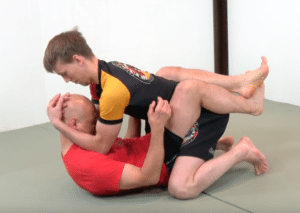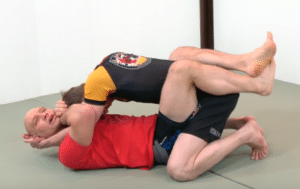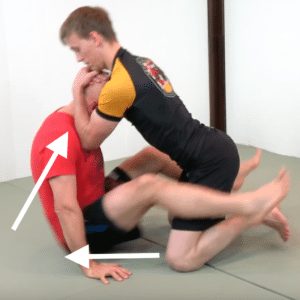Neck cranks are undeniably powerful submissions often used in submission grappling. Rather than constricting the trachea and arteries at the front and sides of the neck like most chokes, a neck crank typically attacks the cervical spine itself.
The trouble is, if you’re on the receiving end of one of these attacks and don’t tap out fast enough then you can sustain a long-lasting or even permanent injury.
Now neck cranks aren’t legal everywhere, but you can run into them in no gi and MMA sparring. Or even in BJJ class if some mouth-breathing steroid monster decided to attend gi class for the day as part of his ‘training UFC’ plan.
So you need to know the basics and be on the alert for them.
Today I want to talk about the ‘can opener’ submission, which is one of the more common neck crank attacks.

The Can Opener Neck Crank
This is one of the very few submissions that can be applied from inside an opponent’s closed guard.
Essentially you reach forward, cup the top of your opponent’s head, plant your elbows in his chest, and then force his chin down towards his sternum. Some people even put their own chins on top of their hands, allowing them to push the head down with even more force.
Georges St Pierre, the phenomenal MMA fighter, often used it as part of his ground and pound strategy in his UFC fights. Not only did he use the can opener to inflict damage and set up his strikes, he also used it to open up really stubborn closed guards so he could then blast past the legs and get to side control.
In the video below we show you how to do the can opener neck crank, and then we cover three technical defences that’ll prevent you from getting hurt and/or tapping out when someone tries to do this technique on you.
Check out the video, or scroll further to get a quick text overview of each defense…
Although not a technical defense per se, the most important part of defending the can opener neck crank is awareness and the willingness to tap.
When it comes to defending any technique, the ability to see it coming is a HUGE advantage.
And the best way to see an attack coming is to have drilled the attack yourself. So even if you have no intention to ever use this attack yourself you should still play with it a few times, just to become comfortable with it and allow you to spot it when your opponent is thinking about attacking you with it.
Once you’ve done it to your training partner a few times and realised the power of this move then it’ll be much easier to figure out what he’s up to when he lunges towards your head with both hands as if he’s going for a Thai clinch.
Also, it’s incredibly important to realise that neck cranks are NOT an area where you want to be a hero. Gritting your teeth and suffering is not a strategy. Once the adrenaline wears off you could be in for a rude surprise: pinched nerves, torn ligaments, damage to the vertebra, and a very long break from training are all possible.
Cervical neck injuries are incredibly debilitating for grapplers, and you want to avoid them at all costs. If legitimately caught, tap early and tap often.
The first technical defense is the to armbar your opponent as he’s reaching forward.

The armbar is NOT a defense you can do when this attack is fully locked on, but in the early stages, when your opponent is still reaching forward to get his hands on your head, it’s solid gold.
There are different ways to move into the armbar, but the simplest way is to control one elbow, reach under the opposite side knee with the other hand, and swing into position (click here to read The Easiest Way to Teach and Learn the Armbar from Guard).
If he tries to hang onto your head then often this will just work against him and make the armbar even tighter.
The next technical defense is to stuff his head down below your head using both your hands.

In the picture above you’ll notice that as my partner secures his can opener grip I’ve taken his head and stuffed it down towards my chest using both of my hands.
This puts him in a very biomechanically disadvantageous position, because it’s hard for him to pull my head down when his arms are extended this far above his own head.
Notice I’ve got both of my hands on top of his head, proving padding between his skull and my jaw. This helps prevent him pile-drivering the top of his head into the relatively vulnerable underside of my face, making the resultant position much more comfortable for me.
Once his head is stuffed like this I can start to climb my legs and threaten an armbar. Either I actually get the armbar or he lets go and retreats; either way I’m out of the neck crank and out of danger.
The final defense is to uncross the ankles, put the hands on the ground, and sit up.

Even if the neck crank is almost fully locked in then you still have one last chance to defend it.
One of the things keeping you locked in place (and making the neck crank tighter) are your ankles crossed behind his back.
So abandon the closed guard: open your ankles and prepare to sit up. And sitting up is made MUCH easier if you put your hands on the ground and use them to scoot your hips back.
As we discussed in the video at the top of this article, once you’re sitting up you might be out of the can opener but you’re not out of danger. Get rid of his grips and fight him from the open guard while looking out for him trying to stuff your head, pass your guard, or attack with a guillotine.
There are, of course, other defences to the can opener neck crank, but these are three great places to start.
Stay safe, and good luck with your training
Stephan Kesting
P.S. If you’re interested in learning more about shutting down your opponent’s guard passes then I highly recommend The Guard Retention Formula instructional.
Click here for more information about The Guard Retention Formula, the detailed instructional on how you can make it really, really difficult for your opponent to pass your guard and give you the confidence to attack from the bottom knowing that you can recover no matter what happens.
Anyway, hope to stay in touch through one or more of those additional mechanisms!
The post Three Powerful Neck Crank Defenses appeared first on Grapplearts.

